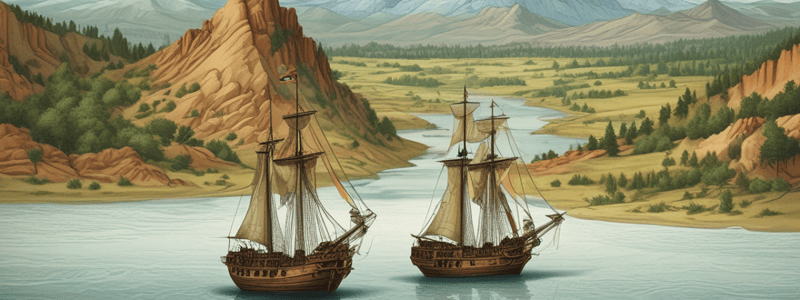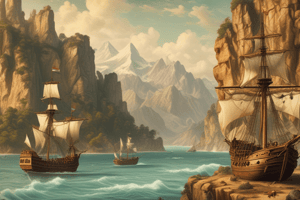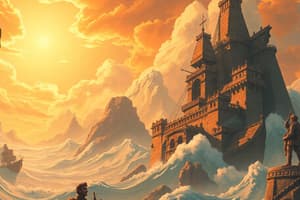Podcast
Questions and Answers
What was the primary motivation for European explorers to venture to the New World?
What was the primary motivation for European explorers to venture to the New World?
- To escape religious persecution
- To find new trade routes and break the duopoly of Genoa and Venice (correct)
- To establish colonies and gain new land
- To spread the Catholic faith
What was the name of the Latin phrase used by European explorers to describe the Americas?
What was the name of the Latin phrase used by European explorers to describe the Americas?
- Americas Nova
- Nova Terra
- Terra Nova
- Mundus Novus (correct)
Which of the following was NOT a motivation for European exploration and colonization?
Which of the following was NOT a motivation for European exploration and colonization?
- Establishing trade relationships with the Native Americans (correct)
- Spreading the Christian faith
- Access to new natural resources
- Acquiring new land for colonies
What regions of the world are referred to as the Old World?
What regions of the world are referred to as the Old World?
What was the main consequence of the introduction of smallpox to the Native American population?
What was the main consequence of the introduction of smallpox to the Native American population?
What was the Columbian Exchange primarily characterized by?
What was the Columbian Exchange primarily characterized by?
What was the primary reason for the distinction between the Old World and the New World?
What was the primary reason for the distinction between the Old World and the New World?
What was the outcome of the Atlantic slave trade initiated during the Age of Exploration?
What was the outcome of the Atlantic slave trade initiated during the Age of Exploration?
Which of the following European countries was NOT a major player in the Age of Exploration?
Which of the following European countries was NOT a major player in the Age of Exploration?
What was the significance of the Vikings' journey to North America around 1000 AD?
What was the significance of the Vikings' journey to North America around 1000 AD?
What is the primary reason for the distinction between the Old World and the New World being considered Eurocentric?
What is the primary reason for the distinction between the Old World and the New World being considered Eurocentric?
What was the significance of the Age of Discovery in terms of intercontinental trade?
What was the significance of the Age of Discovery in terms of intercontinental trade?
Which civilization was NOT a part of the Old World?
Which civilization was NOT a part of the Old World?
What was the primary region of Asia that was familiar to European explorers?
What was the primary region of Asia that was familiar to European explorers?
Which of the following countries was NOT a major player in building vast overseas empires in the New World?
Which of the following countries was NOT a major player in building vast overseas empires in the New World?
What was the main reason for the Portuguese explorers' desire to explore new trade routes?
What was the main reason for the Portuguese explorers' desire to explore new trade routes?
Which two Native American civilizations were the most advanced at the time of Columbus' voyage?
Which two Native American civilizations were the most advanced at the time of Columbus' voyage?
What was the primary reason for the English settlers to colonize the New World?
What was the primary reason for the English settlers to colonize the New World?
Which of the following was a consequence of the Columbian Exchange?
Which of the following was a consequence of the Columbian Exchange?
What was the significance of the phrase 'Gold, Glory, God' in the context of the Age of Exploration?
What was the significance of the phrase 'Gold, Glory, God' in the context of the Age of Exploration?
Flashcards are hidden until you start studying
Study Notes
Old World vs New World
- The Old World refers to Europe, Africa, and Asia, while the New World refers to North America, South America, and the Caribbean.
- The terms are Eurocentric, and indigenous inhabitants of the New World did not consider their homes to be newly-discovered parts of the world.
The Old World
- The Old World was home to great civilizations, including ancient Greece and Rome.
- European countries that built vast overseas empires in the New World include England, France, Spain, Portugal, and the Netherlands.
- The Atlantic slave trade initiated during the Age of Exploration, where black Africans were brought to the New World to work as slaves on plantations.
- Asia was also part of the Old World, with Europeans being familiar with western Asia, but less familiar with eastern Asia.
The New World
- The New World was first discovered by Christopher Columbus in 1492, which was a major revelation to Europeans.
- There were thousands of Native American cultures, some with highly advanced civilizations, but most were wiped out by contact with Europeans.
- The two most advanced Native American civilizations that existed in the Americas at the time of Columbus' voyage were the Aztec in Central America and the Inca in South America.
Modern-Day New World Countries
- Some modern-day countries that exist in the New World include:
- The United States
- Canada
- Brazil
- Mexico
- Colombia
- Venezuela
- Cuba
- The Bahamas
- Argentina
Reasons for European Exploration and Colonization
- European exploration was spurred by the desire to find new trade routes, access to natural resources, acquiring new land for colonies, spreading the Christian faith, and making their home countries more powerful.
- The phrase "Gold, Glory, God" best explains these motivations.
England's Exploration
- England didn't begin colonizing the New World until the early 17th century.
- Many early settlers in North America were Puritans escaping religious persecution, while others were interested in growing valuable crops.
- 13 English colonies would eventually break away from their homeland to form the United States of America.
New World History
- The Columbian Exchange refers to the exchange of crops, animals, diseases, and people between the Old World and the New World.
- The exchange led to the introduction of many new foods into Europe, including corn, potatoes, tomatoes, and squash.
- Spreading the Catholic faith to the New World was of major importance to Spanish, Portuguese, and French explorers.
- The conversion process was largely the task of priests, who acted as missionaries to the Native American people.
Old World vs New World
- The Old World refers to Europe, Africa, and Asia, while the New World refers to North America, South America, and the Caribbean.
- The terms are Eurocentric, and indigenous inhabitants of the New World did not consider their homes to be newly-discovered parts of the world.
The Old World
- The Old World was home to great civilizations, including ancient Greece and Rome.
- European countries that built vast overseas empires in the New World include England, France, Spain, Portugal, and the Netherlands.
- The Atlantic slave trade initiated during the Age of Exploration, where black Africans were brought to the New World to work as slaves on plantations.
- Asia was also part of the Old World, with Europeans being familiar with western Asia, but less familiar with eastern Asia.
The New World
- The New World was first discovered by Christopher Columbus in 1492, which was a major revelation to Europeans.
- There were thousands of Native American cultures, some with highly advanced civilizations, but most were wiped out by contact with Europeans.
- The two most advanced Native American civilizations that existed in the Americas at the time of Columbus' voyage were the Aztec in Central America and the Inca in South America.
Modern-Day New World Countries
- Some modern-day countries that exist in the New World include:
- The United States
- Canada
- Brazil
- Mexico
- Colombia
- Venezuela
- Cuba
- The Bahamas
- Argentina
Reasons for European Exploration and Colonization
- European exploration was spurred by the desire to find new trade routes, access to natural resources, acquiring new land for colonies, spreading the Christian faith, and making their home countries more powerful.
- The phrase "Gold, Glory, God" best explains these motivations.
England's Exploration
- England didn't begin colonizing the New World until the early 17th century.
- Many early settlers in North America were Puritans escaping religious persecution, while others were interested in growing valuable crops.
- 13 English colonies would eventually break away from their homeland to form the United States of America.
New World History
- The Columbian Exchange refers to the exchange of crops, animals, diseases, and people between the Old World and the New World.
- The exchange led to the introduction of many new foods into Europe, including corn, potatoes, tomatoes, and squash.
- Spreading the Catholic faith to the New World was of major importance to Spanish, Portuguese, and French explorers.
- The conversion process was largely the task of priests, who acted as missionaries to the Native American people.
Studying That Suits You
Use AI to generate personalized quizzes and flashcards to suit your learning preferences.




